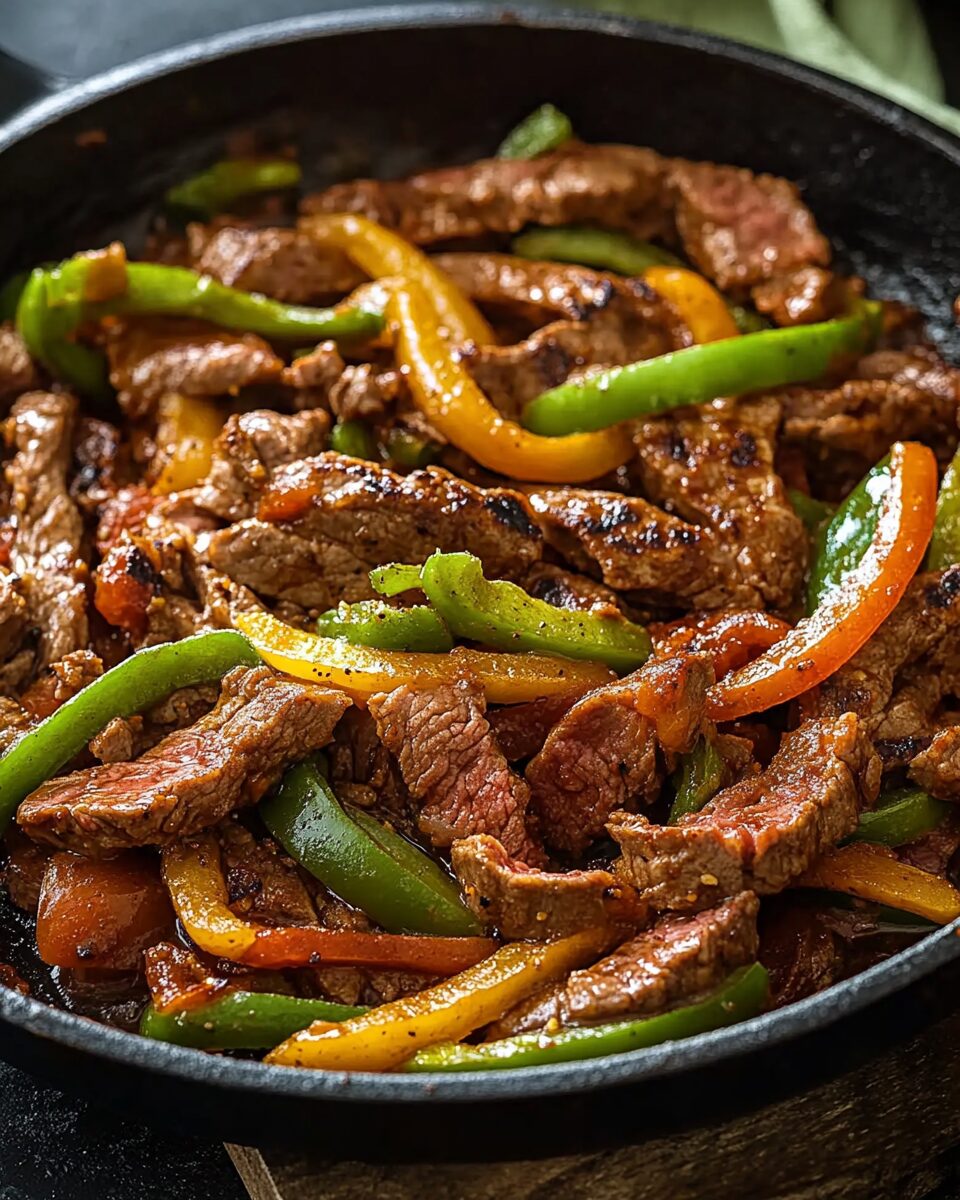Pepper Steak is a vibrant and flavorful dish that brings together tender slices of beef, a colorful medley of bell peppers, and a savory sauce. The caramelized onions and peppers add a sweet and smoky dimension, perfectly complementing the umami-rich sauce coating the steak.
This dish is an ideal choice for busy weeknights, offering a restaurant-quality meal with minimal effort. Serve it over steamed rice or noodles for a satisfying and well-rounded dinner. With its eye-catching colors and bold flavors, this recipe is sure to impress family and friends alike.
Full Recipe:
Ingredients:
- 1 lb (450 g) flank steak, thinly sliced
- 1 tablespoon soy sauce
- 1 tablespoon oyster sauce
- 1 teaspoon sesame oil
- 2 tablespoons cornstarch
- 2 tablespoons vegetable oil
- 1 red bell pepper, sliced
- 1 green bell pepper, sliced
- 1 yellow bell pepper, sliced
- 1 medium onion, sliced
- 2 cloves garlic, minced
- 1/4 cup beef broth
- 2 tablespoons hoisin sauce
- 1 teaspoon sugar
- 1/4 teaspoon black pepper
Directions:
- In a bowl, combine the steak slices with soy sauce, oyster sauce, sesame oil, and cornstarch. Let it marinate for 15 minutes.
- Heat 1 tablespoon of vegetable oil in a large skillet or wok over medium-high heat. Sear the marinated steak slices in batches until browned. Remove and set aside.
- In the same skillet, add the remaining oil and sauté the onions and garlic for 2-3 minutes until fragrant.
- Add the sliced bell peppers and stir-fry for 4-5 minutes until tender-crisp.
- Return the cooked steak to the skillet and pour in the beef broth, hoisin sauce, sugar, and black pepper. Stir everything together and let it simmer for 3-4 minutes until the sauce thickens and coats the steak and vegetables.
- Serve hot over steamed rice or noodles.
Prep Time: 15 minutes | Cooking Time: 20 minutes | Total Time: 35 minutes
Kcal: 320 kcal | Servings: 4 servings
History and Origin
Pepper Steak is a classic dish that originates from Chinese-American cuisine. Its roots trace back to traditional Chinese stir-fry techniques, where beef and vegetables are quickly cooked over high heat with savory sauces. The dish became popular in the United States during the mid-20th century as Chinese cuisine adapted to local ingredients and tastes. Bell peppers, not a common ingredient in traditional Chinese cooking, were incorporated to add sweetness, crunch, and vibrant colors, making the dish visually appealing and delicious.
Nutritional Benefits
Pepper Steak is a well-balanced dish that combines protein, vegetables, and a flavorful sauce. It is:
- High in protein: Thanks to the flank steak, it supports muscle growth and repair.
- Rich in vitamins: Bell peppers are loaded with vitamin C, vitamin A, and antioxidants, which support immune health and skin vitality.
- Low in carbs (if served without rice or noodles): Making it a great option for low-carb or keto diets.
- Customizable for dietary needs: You can use low-sodium soy sauce for reduced sodium intake or swap beef for tofu or chicken for alternative proteins.
Cooking Tips and Tricks
- Choose the right cut of beef: Flank steak, sirloin, or skirt steak are ideal for Pepper Steak. Slice the meat thinly against the grain to ensure tenderness.
- Get the perfect stir-fry texture: Use high heat and cook the ingredients quickly to maintain the crunchiness of the peppers and the juiciness of the steak.
- Marinate for flavor: Letting the beef marinate in soy sauce, oyster sauce, and sesame oil enhances the flavor and tenderizes the meat.
- Adjust the sauce: Add a splash of rice vinegar or a hint of chili flakes for a tangy or spicy kick. For a thicker sauce, mix 1 teaspoon of cornstarch with 1 tablespoon of water and stir it in during the last minute of cooking.
Variations and Serving Ideas
- Serve with grains: Pair Pepper Steak with steamed jasmine rice, quinoa, or cauliflower rice for a wholesome meal.
- Add more veggies: Broccoli, snap peas, or mushrooms can complement the flavors of the dish and boost its nutritional value.
- Make it spicy: Add sliced red chilies or chili oil for those who love a bit of heat.
- Turn it low-carb: Skip the rice and serve it over zucchini noodles or a bed of leafy greens.
- Meal prep-friendly: Cook a double batch and store in airtight containers for quick meals during the week.
Fun Fact
Did you know that bell peppers come in multiple colors, not just for aesthetics but also for their ripeness and nutritional value? Red peppers are fully ripened and sweeter compared to green peppers, which are less mature and slightly bitter. Using a mix of red, yellow, and green bell peppers in your Pepper Steak not only enhances the flavor profile but also provides a broader spectrum of vitamins and nutrients.
Pairing Suggestions
Pepper Steak pairs wonderfully with light and refreshing side dishes like cucumber salad, pickled vegetables, or an egg drop soup. For beverages, consider serving it with green tea, a light lager, or a chilled white wine such as Sauvignon Blanc to balance the savory flavors of the dish.

